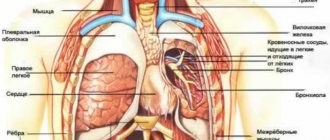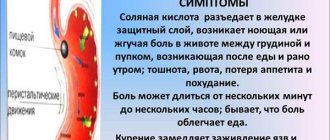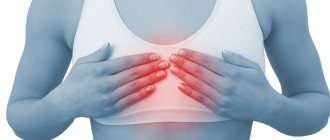Pain in the chest in the middle: causes
There can be many reasons why pain appears in the middle of the chest, so it is worth considering the intensity of the pain syndrome, its frequency and the specific location of the pain. By doing this, it will be possible to narrow down the search for pathology leading to unpleasant sensations.
Heart pathologies
Chest pain is often associated with diseases of the cardiovascular system and heart. If you feel thoracalgia all the time, this may indicate an aortic aneurysm. In this case, pain in the left or right side of the chest is felt for a long time, and it will become stronger whenever the person moves from rest to physical activity. The condition can only be treated surgically, so if this diagnosis is confirmed, hospitalization will be required. Pain in the center of the chest in front may also appear if pulmonary embolism develops. The pain becomes more severe when you inhale, and taking analgesics can suppress it. Compressive pain may indicate that a person has exertional angina, and pain may also be a symptom of myocardial infarction
.
Respiratory damage
If pain appears in the front center of the chest, and you feel shortness of breath, cannot breathe deeply, have a cough and shortness of breath, the problem may be the occurrence of pulmonary diseases, which include tracheitis, pneumonia, bronchitis, pleurisy and some others. The same symptoms can occur with diseases of the diaphragm.
Injuries
Pain in the front of the chest, in the middle, or between the ribs can occur in a person who has had an accident, been involved in a fight, or damaged the structure of the chest due to a fall or blow. Such pain intensifies when he tries to turn around, bend over, take a deep breath, and is explained by the fact that blood vessels rupture, the periosteum is damaged, cracks and fractures form. In such a situation, at rest, the pain syndrome can disappear almost completely, which gives a person false confidence that there is no need to see a doctor.
Spinal diseases
The most common reason why the chest hurts in the middle is osteochondrosis, if we talk about pathologies of the spinal column. Pain with osteochondrosis can be constant or manifest itself in the form of attacks. The pain will be of the same intensity and manifestation with radiculopathy in the thoracic spine. Pain syndrome may also indicate an intervertebral hernia and congenital anomalies in the structure of the spinal column.
Neurological diseases
The causes of pain in the chest in the middle can be neuralgic in nature. The most common diagnosis in this case is intercostal neuralgia, in which there is a lot of pain in the sternum, radiating to the back under the shoulder blade, which is why it is easy for a person to confuse the pain with heart pain.
Problems with the esophagus
Pain in the shoulder blades and in the middle of the chest may be associated with pathologies of the esophagus. The cause in this case is usually a spasm, which manifests itself more often in the morning or after eating. Pain in the chest area is relieved by taking antispasmodic drugs. Often spasms of the esophagus are accompanied by spasms of the muscular walls of the stomach.
Treatment
Help before diagnosis
Heaviness in the chest occurs when various organs and systems are affected, so self-medication at home is unacceptable and is fraught with the progression of the underlying disease and the development of complications. Patients experiencing chest discomfort are advised not to delay contacting a therapist. If squeezing pain is felt in the chest, the person experiences suffocation, febrile fever, and requires emergency medical attention.
Conservative therapy
Treatment measures are selected after identifying the causes of the condition. Heaviness in the chest does not require special symptomatic therapy and disappears after eliminating the underlying pathology. All patients are prescribed a gentle motor regimen, maximum limitation of stress and traumatic factors. Medicinal effects include drugs from the following pharmacological groups:
- Antianginal agents
. Used in combinations for long-term therapy of coronary heart disease. They are supplemented with antiplatelet agents to prevent myocardial infarction and thrombosis. Nitrates are recommended to relieve angina attacks. - Anti-inflammatory drugs
. Nonsteroidal anti-inflammatory drugs are indicated for myocarditis and pericarditis, acute respiratory diseases. They act pathogenetically and also relieve discomfort and pain. If nonsteroidal drugs are ineffective, corticosteroids are taken. - Antibiotics
. Antimicrobial drugs are prescribed for pneumonia, pleurisy, purulent bronchitis as etiotropic treatment. Penicillin antibiotics are effective for inflammatory lesions of the heart due to rheumatism. To treat tuberculosis, 3-4 specific drugs are combined. - Antiallergic drugs
. Leukotriene receptor antagonists and mast cell membrane stabilizers are used for basic therapy of bronchial asthma. Classic antihistamines are used as pathogenetic therapy for many inflammatory processes with an allergic component. - Metabolic drugs
. To improve the delivery and utilization of oxygen in the myocardium under conditions of ischemia, it is necessary to take cytoprotectors. Therapy is enhanced with ascorbic acid and B vitamins, which accelerate metabolic processes in the body.
How to relieve pain. First aid
Often a person who has pain in the middle of the chest does not know what to do in such a situation. Some people experience so much pain that they faint. In this case, severe fear is observed, the pulse rate increases, and the skin turns pale. The first thing to do if a person suddenly experiences severe pain in the sternum, internal organs and spine:
- call an ambulance;
- put the person in bed, slightly raising his legs;
- remove clothes that constrict the chest and interfere with breathing, give a nitroglycerin tablet, which will dilate the blood vessels and improve the condition of the victim.
Also, if a person has pain in the middle of the chest, it is best to ask everyone present to leave the room and ensure complete rest for the patient until the ambulance arrives.
Pulmonary pathologies
There are many causes of pain in the sternum during inspiration, which are associated with pathologies of the respiratory system. It is worth considering some cases when pain may appear when inhaling.
Pneumothorax
It is an accumulation of gas in the pleural cavity, which leads to the collapse of lung tissue, from which the process occurs. In this case, the mediastinum shifts towards the healthy organ, the blood vessels are compressed, which leads to respiratory disorders, and blood circulation is also impaired. Often pneumothorax is traumatic, and can also be a consequence of spontaneous disruption of tissue integrity.
Pleuropneumonia
If chest pain appears when taking a deep breath, this may indicate progressive pulmonary pneumonia, when the pleura is involved in the pathological process. This disease is very dangerous; Along with pain when inhaling, a person notes the inability to take a deep breath and general weakness.
Pleurisy
Inflammation of the serous membrane of the lungs is called pleurisy and may be accompanied by pain when inhaling. In this case, a person not only has pain in the chest area when inhaling, but also shortness of breath, cough, pulmonologist
notes pleural friction noise when listening to breathing, and the temperature also rises.
Lungs' cancer
Pain in the middle of the chest when inhaling can occur if a malignant neoplasm has developed in the lungs. Pain syndrome is a consequence of tissue proliferation and compression of neighboring structures. To determine why your chest begins to hurt when you inhale and move, first consult a neurologist
, who, after a survey and examination, will refer you to a specialist.
Diagnostics
The first thing the doctor will do is interview and examine the patient, which will allow him to narrow the search for pathology based on associated symptoms. After this, various diagnostic procedures may be prescribed to determine the cause of the pain. Magnetic resonance imaging may be helpful
or
computed tomography
,
x-ray
, ultrasound, blood tests, etc. This will determine why pain occurs in the middle of the chest, which radiates to the back, upper limbs or ribs.
Diseases and pathologies of the heart
Often, when inhaling, pain appears in the left chest if there is a heart problem. In this case, there may be quite a few reasons, and only an experienced pulmonologist
.
Pericarditis
Pericarditis is an inflammation of the heart sac - the outer lining of the heart, which is called the “pericardium”. The nature of such a disease can be infectious, rheumatic, or result from a heart attack. With pericarditis, not only does pain appear when inhaling on the right or left side of the chest; the condition is often accompanied by severe weakness, as well as shortness of breath if fluid leaks between the layers of the pericardium. Pericarditis with effusion can develop into suppuration and cause compression of the heart by accumulated secretions.
Pulmonary embolism
This is the name of the condition when the pulmonary arteries stop passing blood, i.e. clogged. This is a consequence of a blood clot (thrombus), drops of fat, bone marrow, catheter element or other foreign body entering the arterial bed. In this case, when inhaling, pain occurs in the left side of the chest, and the person needs urgent medical attention.
Which doctor should I contact?
If you are able to visit the clinic yourself, you can make an appointment with a GP
. He will determine the approximate cause of the pain and the direction of further search, and will also give you directions for diagnostic procedures and, if necessary, to specialized specialists. If there is acute pain in the middle of the chest, it is difficult and difficult to move, you cannot get out of bed without pain, call an ambulance. After examining you at home, a specialist will provide first aid and determine whether you need to be taken to the hospital.
Spinal problems
Chest pain when inhaling often appears due to pathologies of the spinal column. The fact is that the spine contains a huge number of nerve endings, inflammation and/or infringement of which can lead to pain radiating into the chest, causing pain when inhaling.
Osteochondrosis
It is a serious disease that affects the cartilage tissue of the spinal column. The intervertebral discs thin out and become less durable, resulting in a decrease in the distance between the vertebrae. Because of this, nerve tissue is pinched, which leads to pain. If the pain intensifies when you inhale, this may indicate that the thoracic spine is affected.
Intercostal neuralgia
Sharp acute pain in the chest when inhaling occurs when compression or irritation of the nerve roots that are located between the ribs occurs. This condition can last literally a couple of minutes or drag on for a day, preventing the person from taking a deep breath and causing significant discomfort. The pain can come on suddenly, for no apparent reason, and often makes a person worry and think that the heart is stabbing, although the reason is completely different.
Fractured ribs
If you have recently been injured and experience pain in your chest when you inhale, you may suspect a rib fracture. This is a dangerous condition, and with a visit to a traumatologist
/
the surgeon
cannot hesitate, since, among other things, you may have damage to internal organs. The fracture itself, depending on its severity, can provoke additional damage.










